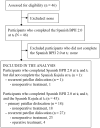Translation and Validation of the Spanish Version of the Banff Patellofemoral Instability Instrument 2.0
- PMID: 39678439
- PMCID: PMC11645779
- DOI: 10.1177/23259671241298306
Translation and Validation of the Spanish Version of the Banff Patellofemoral Instability Instrument 2.0
Abstract
Background: The Banff Patellofemoral Instability Instrument (BPII) 2.0 is a patient-reported outcome measure (PROM) tailored specifically for patellofemoral instability. The BPII 2.0 was developed in English and has been validated for adolescents and translated into several languages, but not into Spanish.
Purpose/hypothesis: This investigation involved translating the BPII 2.0 into Spanish and evaluating and validating its psychometric properties. It was hypothesized that there would be a moderate correlation between the Spanish BPII 2.0 and the Spanish version of the Kujala score.
Study design: Cohort study (diagnosis); Level of evidence, 3.
Methods: The BPII 2.0 underwent forward and backward translations into Colombian Spanish according to the Consensus-Based Standards for the Selection of Health Measurement Instrument guidelines. Colombian patients aged 9 to 18 years who experienced knee symptoms after a primary or recurrent patellar dislocation were recruited from a hospital-based orthopaedic clinic. Participants completed the Spanish BPII 2.0 and the Kujala score during their initial visit (t0) and the Spanish BPII 2.0 again 1 week later (t1). Internal consistency and test-retest reliability were assessed using the intraclass correlation coefficient (ICC). Concurrent validity of the Spanish BPII 2.0 with the Kujala score was explored through Pearson correlation analysis.
Results: A total of 46 participants (31 [67%] female; mean age, 15.1 ± 2.0 years) were included. The mean time since first patellofemoral dislocation was 22 ± 28 months. Of the 4 participants who received operative treatment for patellar instability, the mean time since surgery was 12 months (range, 7-18 months). All patients completed the BPII 2.0 at t0 and at t1, a mean of 7 days later (range, 6-7 days), and 45 (98%) participants completed the Kujala score at t0. Five Spanish BPII 2.0 items exhibited floor or ceiling effects, however no subscales demonstrated these effects. Th Spanish BPII 2.0 demonstrated excellent internal consistency at both t0 (ICC, 0.94; 95% CI, 0.92-0.96) and t1 (ICC, 0.96; 95% CI, 0.93-0.97), along with excellent test-retest reliability (ICC, 0.98; 95% CI, 0.97-0.99). Concurrent validity of the Spanish BPII 2.0 with the Spanish Kujala score was good to strong (r = 0.74; 95% CI, 0.57-0.85).
Conclusion: The Spanish BPII 2.0 had excellent internal consistency and test-retest reliability, suggesting this PROM is a reliable and valid questionnaire.
Keywords: adolescent; child; patellar dislocation; patellofemoral instability; patient-reported outcome measure; translation; validation.
© The Author(s) 2024.
Conflict of interest statement
The authors declared that there are no conflicts of interest in the authorship and publication of this contribution. AOSSM checks author disclosures against the Open Payments Database (OPD). AOSSM has not conducted an independent investigation on the OPD and disclaims any liability or responsibility relating thereto. Ethical approval for this study was obtained from Fundación Valle del Lili (ref No. 299-2020).
Figures
References
-
- Arendt EA, Askenberger M, Agel J, Tompkins MA. Risk of redislocation after primary patellar dislocation: a clinical prediction model based on magnetic resonance imaging variables. Am J Sports Med. 2018;46(14):3385-3390. - PubMed
-
- Askenberger M, Bengtsson Moström E, Ekström W, et al.. Operative repair of medial patellofemoral ligament injury versus knee brace in children with an acute first-time traumatic patellar dislocation: a randomized controlled trial. Am J Sports Med. 2018;46(10):2328-2340. - PubMed
-
- Askenberger M, Ekström W, Finnbogason T, Janarv P-M. Occult intra-articular knee injuries in children with hemarthrosis. Am J Sports Med. 2014;42(7):1600-1606. - PubMed
-
- Becher C, Attal R, Balcarek P, et al.. Successful adaption of the Banff Patella Instability Instrument (BPII) 2.0 into German. Knee Surg Sports Traumatol Arthrosc. 2018;26(9):2679-2684. - PubMed
-
- Bravo G, Potvin L. Estimating the reliability of continuous measures with Cronbach’s alpha or the intraclass correlation coefficient: toward the integration of two traditions. J Clin Epidemiol. 1991;44(4-5):381-390. - PubMed
LinkOut - more resources
Full Text Sources


